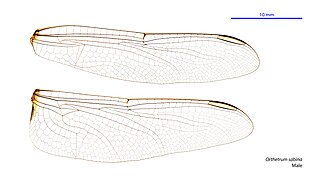Orthetrum sabina
| Orthetrum sabina | |
|---|---|

| |
| Male, Cyprus | |

| |
| Female, Nepal | |
| Scientific classification | |
| Domain: | Eukaryota |
| Kingdom: | Animalia |
| Phylum: | Arthropoda |
| Class: | Insecta |
| Order: | Odonata |
| Infraorder: | Anisoptera |
| Family: | Libellulidae |
| Genus: | Orthetrum |
| Species: | O. sabina
|
| Binomial name | |
| Orthetrum sabina | |

| |
| Synonyms | |
| |
Orthetrum sabina, the slender skimmer[1] or green marsh hawk,[3] is a species of dragonfly in the family Libellulidae.[4][5] It is widespread, being found from south-eastern Europe and North Africa to Japan and south to Australia and Micronesia.[6][7]
Description and habitat
[edit]It is a medium-sized dragonfly with a wingspan of 60-85mm. Adults are greyish to greenish yellow with black and pale markings and green eyes. Its abdomen is greenish-yellow, marked with black.[8] It is very similar to Orthetrum serapia in appearance, with both species appearing in northern Australia. Pale markings on segment four of the abdomen do not extend into the posterior section when viewed from above on Orthetrum sabina. Females are similar to males in shape, colour and size; differing only in sexual characteristics.[8][9] This dragonfly perches motionless on shrubs and dry twigs for long periods. It preys voraciously on smaller butterflies and dragonflies.[8][10][11][12]

Gallery
[edit]-
Female
-
Male
-
Old male with darkened abdomen and thorax
-
Orthetrum sabina feeding Tetrathemis platyptera
-
Mating pair
-
in flight
-
Female wings
-
Male wings

See also
[edit]- List of odonates of Sri Lanka
- List of odonates of India
- List of odonata of Kerala
- List of Odonata species of Australia
References
[edit]- ^ a b Mitra, A. (2020). "Orthetrum sabina". IUCN Red List of Threatened Species. 2020: e.T165470A83377025. doi:10.2305/IUCN.UK.2020-1.RLTS.T165470A83377025.en. Retrieved 20 November 2021.
- ^ Drury, D. (1770). Illustrations of Natural History; wherein are exhibited upwards of two hundred and forty figures of exotic insects according to their genera. London: White. pp. 130 [114]. doi:10.5962/bhl.title.61910 – via Biodiversity Heritage Library.
- ^ Subramanian, K. A. (2005). Dragonflies and Damselflies of Peninsular India (PDF).
- ^ "Species Orthetrum sabina (Drury, 1770)". Australian Faunal Directory. Australian Biological Resources Study. 2012. Retrieved 1 March 2017.
- ^ Schorr, Martin; Paulson, Dennis. "World Odonata List". Slater Museum of Natural History. University of Puget Sound. Retrieved 1 March 2017.
- ^ Watson, J.A.L.; Theischinger, G.; Abbey, H.M. (1991). The Australian Dragonflies: A Guide to the Identification, Distributions and Habitats of Australian Odonata. Melbourne: CSIRO. p. 278. ISBN 0643051368.
- ^ K.A., Subramanian; K.G., Emiliyamma; R., Babu; C., Radhakrishnan; S.S., Talmale (2018). Atlas of Odonata (Insecta) of the Western Ghats, India. Zoological Survey of India. pp. 357–358. ISBN 9788181714954.
- ^ a b c C FC Lt. Fraser (1936). The Fauna of British India, including Ceylon and Burma, Odonata Vol. III. Red Lion Court, Fleet Street, London: Taylor and Francis. pp. 300–302.
- ^ Theischinger, G; Hawking, J (2006). The Complete Field Guide to Dragonflies of Australia. Collingwood Vic.: CSIRO Publishing. p. 268. ISBN 978 0 64309 073 6.
- ^ C FC Lt. Fraser (1924). A Survey of the Odonate (Dragonfly) Fauna of Western India and Descriptions of Thirty New Species (PDF). p. 432.
- ^ "Orthetrum sabina Drury, 1773". India Biodiversity Portal. Retrieved 2017-02-15.
- ^ "Orthetrum sabina Drury, 1773". Odonata of India, v. 1.00. Indian Foundation for Butterflies. Retrieved 2017-02-15.
External links
[edit]![]() Media related to Orthetrum sabina at Wikimedia Commons
Media related to Orthetrum sabina at Wikimedia Commons
![]() Data related to Orthetrum sabina at Wikispecies
Data related to Orthetrum sabina at Wikispecies









